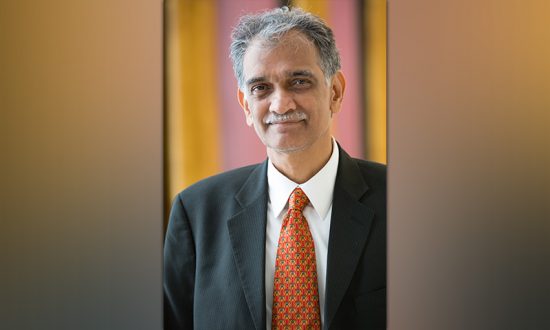Professor Nair is the Dean of Research to Amrita Vishwa Vidyapeetham, and also the Director of Amrita Centre for Nanosciences and Molecular Medicine (ACNSMM), Health Sciences Campus. Dr. Nair received his Bachelor of Technology degree in Metallurgical Engineering from the Indian Institute of Technology, Bombay, India, in 1976; Master of Science (1978) and Doctor of Engineering Science (1983) degrees in Materials Science and Engineering from Columbia University, New York, USA. He joined the faculty of the Mechanical Engineering Department of the University of Massachusetts, Amherst, MA, USA, in 1985 where he has since taught and conducted research in the area of composite materials. In 2006, he joined Amrita Vishwa Vidyapeetham, India. He heads initiatives in the applications of Nanotechnology to Medicine and Energy areas. Areas of research include nanomedicine, tissue engineering, surface modification of materials, and uses of nanomaterials in photovoltaics, supercapacitors and batteries.
Although we are still not quite in the post COVID era one of the remarkable outcomes of the COVID era is the tremendous investment and growth in creative sciences. In the span of a few months so many distinct types of vaccines were developed, including a nano vaccine, from companies such as Pfizer, Johnson and Johnson and Moderna from the USA; Covishield from England and Covovax and Covaxin from India. Today more than 3.4 billion people have been vaccinated already, a phenomenal accomplishment when normally a vaccine takes 5 – 10 years to develop. This truly is the power of creative molecular and nanosciences which is expected to play a huge role in a multitude of fields. Careers in India was heavily weighted in engineering and medicine which are applied and service fields, but today more and more science-based careers, particularly molecular and nanosciences are getting increasingly important in almost every segment of societal importance.
Nano and molecular sciences represent the power of the small. When one goes below 100 nanometers in size extraordinary properties begin to manifest – unexpected biological, electrical, magnetic and mechanical properties which can be harnessed for the good of society in a variety of fields that affect the common person in a positive manner. Furthermore, at these small scales, materials become “intelligent”, and can, for example, seek out diseased cells (such as cancer cells) or pathogens in a targeted fashion and kill them. Such small particles are sometimes called nanobots, which stands for nano robots, to indicate their inherent intelligence. Sometimes they are also called nanomedicines when used for treating diseases.
Let us explore some of these disciplines where creative sciences are taking over. A basic aspect of the new sciences is that they are fundamentally interdisciplinary. Biology, physics, chemistry, and computational sciences merge to create technological breakthroughs in a multitude of application areas.
In healthcare, molecular medicine, medicines designed at the molecular level, provide personalized therapy, nanomedicines that are intelligent can overcome drug resistance, molecular and nano-enabled high resolution medical imaging can detect diseases at a very early stage and smart medical implants can recognize when healing has occurred and can degrade away to be replaced by natural tissue. These are real-life examples of remarkable applications in healthcare. Another field is photonics or light-based applications in health, such using light through lasers to detect cancers and light also to treat diseases because of unique interactions of light with living cells.
Forensic molecular sciences are a powerful area providing many career opportunities. This is not just understanding why death occurred. Forensics represent detection of causes and mechanisms, whether it be illness, the failure of a product, climate change, initiation and growth of pandemics to understanding the origin and death of stars. It also includes crime and fingerprint and facial identification and use of wearable nano trackers to monitor health of people real-time.
Energy and environment extensively use molecular sciences. Clean energy production for renewable resources requires nanomaterials for increased efficiency. Energy storage using nanomaterials for high power batteries and recycled batteries can transform the use and disposal of energy. Also important is energy from biowaste using nano catalysts. Clean water has become a major global need because of increasing and more polluted water sources. Nano-based water purification and nano-based clean water from seawater are becoming a reality. India has a very successful nano product for water purification that has reached millions of people. Sustainable buildings need to use innovative smart materials for energy conservation to keep the inside spaces warm in winter and cool in summer.
Computational sciences are also exploding into the nano and molecular scales. Nano computers use channels less than 100 nanometers in length, quantum computers work at the molecular and quantum scales and change the way algorithms are performed. Beyond these, computational methods are central to applications of many nanomaterials in energy and medicine. This has sometimes been termed the field of bio-nano-info sciences.
National security needs now rely heavily on molecular sciences. Applications include stronger armors, explosive detectors, transportation, smart sensors for detection of biological agents and long-distance high-resolution vision, including night vision, from several tens of meters away using lasers.
In addition to all the above areas are new emerging areas involving intellectual or thought contributions. This includes intellectual property management, think tanks, journalism and scientific writing.
Career opportunities in molecular and nanosciences would embrace the pharma industry, biotech industry, IT sector, materials and manufacturing sector, atmospheric, climate and environmental sectors, electronic devices sector, agriculture and geosciences sectors. This is the post COVID era and we are almost there. What is needed are students who are interested and courageous enough to seek innovative new opportunities which will become the mainstream of the future and that future is not too far away. This is the time to start to prepare for it.




